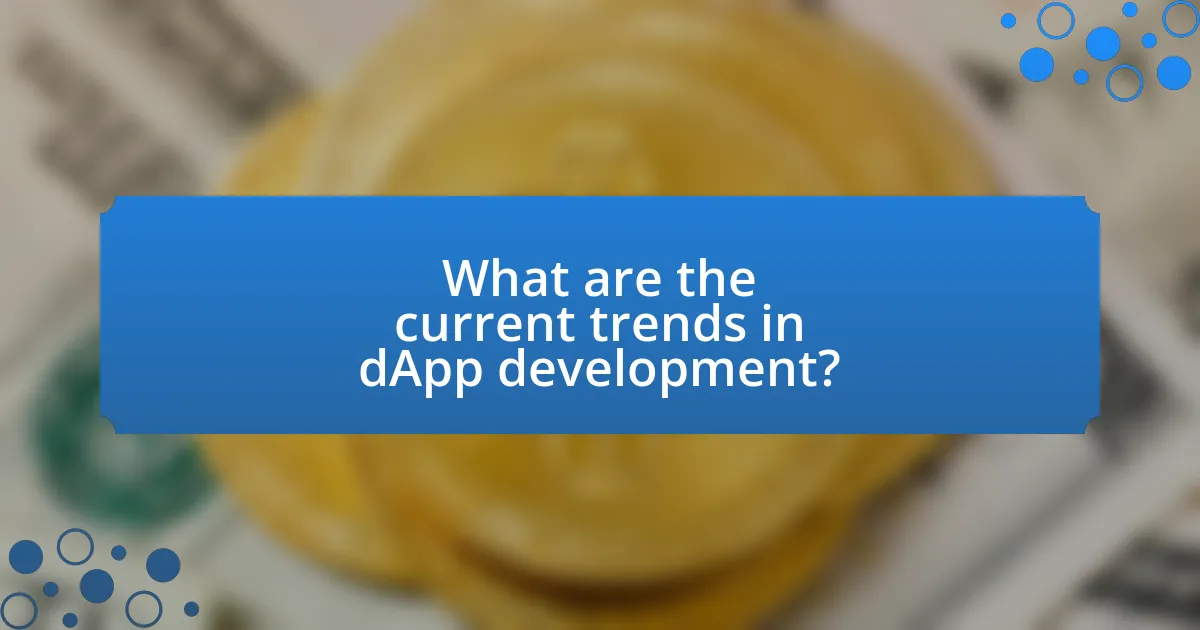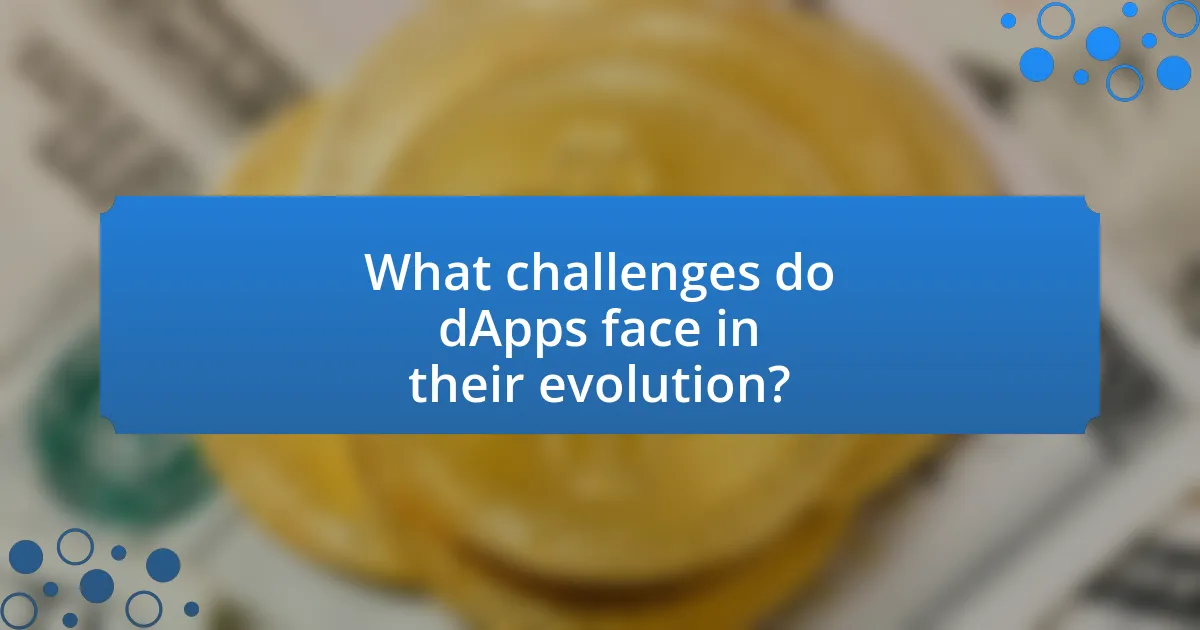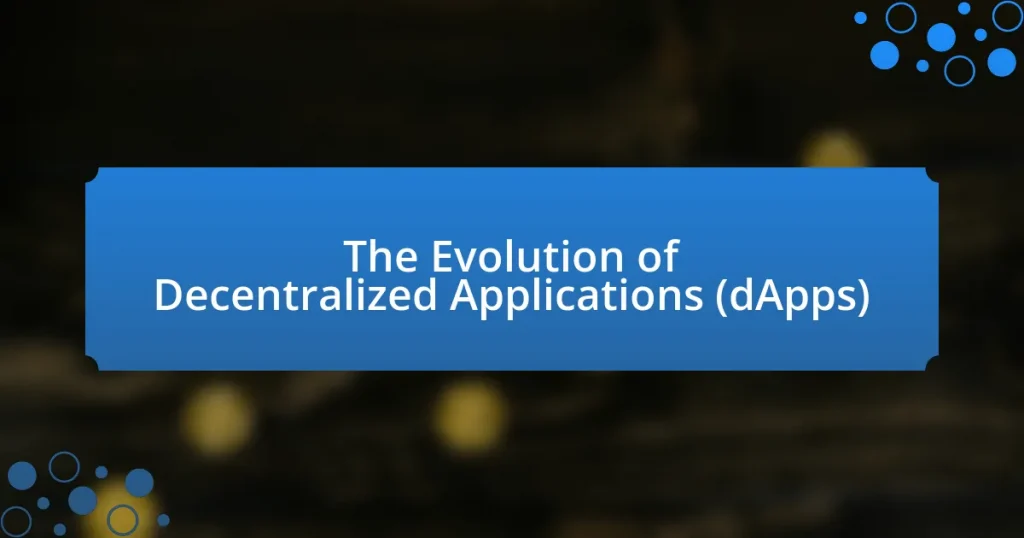Decentralized Applications (dApps) are software applications that operate on blockchain or peer-to-peer networks, utilizing smart contracts to enhance transparency, security, and user control. This article explores the fundamental differences between dApps and traditional applications, highlighting key characteristics such as decentralization, open-source development, and automated processes. It also examines the technologies that underpin dApps, including blockchain and smart contracts, and discusses the historical milestones in their evolution, current trends in development, and the impact of decentralized finance (DeFi) on dApp usage. Additionally, the article addresses challenges faced by dApps, such as scalability and security concerns, while outlining best practices for successful development and potential future use cases across various industries.
-1.webp)
What are Decentralized Applications (dApps)?
Decentralized Applications (dApps) are software applications that run on a blockchain or peer-to-peer network, rather than being hosted on centralized servers. dApps utilize smart contracts to facilitate and automate processes without the need for intermediaries, ensuring transparency and security. For instance, Ethereum is a prominent platform for dApps, enabling developers to create applications that operate autonomously and are resistant to censorship. The decentralized nature of dApps enhances user control and data privacy, distinguishing them from traditional applications that rely on centralized control.
How do dApps differ from traditional applications?
dApps differ from traditional applications primarily in their decentralized architecture. While traditional applications rely on centralized servers and databases to manage data and processes, dApps operate on blockchain technology, which distributes data across a network of nodes. This decentralization enhances security, as there is no single point of failure, and increases transparency, as all transactions are recorded on a public ledger. Additionally, dApps often utilize smart contracts to automate processes without intermediaries, contrasting with traditional applications that typically require third-party services for similar functionalities.
What are the key characteristics of dApps?
Decentralized applications (dApps) are characterized by their reliance on blockchain technology, which ensures transparency, security, and immutability. dApps operate on a peer-to-peer network, eliminating the need for a central authority, which enhances user control and privacy. They are open-source, allowing anyone to inspect, modify, and contribute to the code, fostering community-driven development. Additionally, dApps utilize smart contracts to automate processes and enforce agreements without intermediaries, increasing efficiency and reducing costs. These characteristics collectively contribute to the resilience and trustworthiness of dApps in various applications, from finance to gaming.
Why is decentralization important for dApps?
Decentralization is important for decentralized applications (dApps) because it enhances security, promotes user autonomy, and reduces the risk of censorship. By distributing control across a network rather than relying on a single entity, dApps minimize vulnerabilities to attacks and failures. For instance, the Ethereum blockchain, which hosts numerous dApps, operates on a decentralized network that ensures no single point of failure, making it more resilient against hacking attempts. Additionally, decentralization empowers users by allowing them to interact directly with the application without intermediaries, fostering trust and transparency. This structure also mitigates the risk of censorship, as no central authority can arbitrarily shut down or manipulate the application, exemplified by dApps like Uniswap, which continue to operate despite regulatory scrutiny.
What technologies underpin dApps?
Decentralized applications (dApps) are primarily underpinned by blockchain technology, smart contracts, and decentralized storage systems. Blockchain technology provides a distributed ledger that ensures transparency and security, while smart contracts automate processes and enforce agreements without intermediaries. Decentralized storage systems, such as IPFS (InterPlanetary File System), enable data storage across a network of nodes, enhancing data availability and resilience. These technologies collectively facilitate the creation and operation of dApps, ensuring they function in a decentralized manner, free from central control.
How do blockchain and smart contracts facilitate dApps?
Blockchain and smart contracts facilitate decentralized applications (dApps) by providing a secure, transparent, and programmable environment for their operation. Blockchain technology ensures that all transactions and data are immutable and distributed across a network, which enhances security and trust among users. Smart contracts, which are self-executing contracts with the terms directly written into code, automate processes and enforce agreements without the need for intermediaries. This reduces costs and increases efficiency. For instance, Ethereum, a leading blockchain platform for dApps, allows developers to create smart contracts that can manage complex interactions and transactions, thereby enabling a wide range of applications from finance to gaming.
What role do decentralized networks play in dApp functionality?
Decentralized networks are fundamental to the functionality of decentralized applications (dApps) as they provide a distributed infrastructure that enhances security, transparency, and resilience. By operating on a decentralized network, dApps eliminate single points of failure, ensuring that no single entity controls the application, which mitigates risks of censorship and fraud. For instance, Ethereum, a leading decentralized network, enables smart contracts that automate processes without intermediaries, thereby increasing efficiency and trust among users. This reliance on decentralized networks allows dApps to function autonomously, with data integrity maintained through consensus mechanisms, such as proof of work or proof of stake, which validate transactions across the network.
What are the historical milestones in the evolution of dApps?
The historical milestones in the evolution of decentralized applications (dApps) include the introduction of Bitcoin in 2009, which established the foundational blockchain technology. In 2013, Vitalik Buterin proposed Ethereum, enabling smart contracts and expanding the potential for dApps beyond simple transactions. The launch of Ethereum in 2015 marked a significant milestone, as it provided a platform specifically designed for dApps. In 2017, the rise of Initial Coin Offerings (ICOs) facilitated funding for numerous dApp projects, leading to increased development and adoption. The introduction of decentralized finance (DeFi) protocols in 2020 further propelled dApps into mainstream use, allowing users to engage in financial activities without intermediaries. Each of these milestones has contributed to the growth and diversification of the dApp ecosystem.
How did the introduction of Bitcoin influence dApps?
The introduction of Bitcoin significantly influenced decentralized applications (dApps) by demonstrating the viability of blockchain technology for secure, peer-to-peer transactions. Bitcoin’s launch in 2009 showcased how decentralized networks could eliminate the need for intermediaries, paving the way for developers to create dApps that leverage similar principles of decentralization and trustlessness. The success of Bitcoin inspired the development of Ethereum in 2015, which introduced smart contracts, further expanding the capabilities of dApps beyond simple transactions to complex programmable interactions. This evolution has led to a diverse ecosystem of dApps across various sectors, including finance, gaming, and supply chain management, fundamentally altering how applications are built and operated.
What were the significant developments in the early days of dApps?
The significant developments in the early days of decentralized applications (dApps) include the launch of Ethereum in 2015, which introduced a platform for building smart contracts and dApps, enabling developers to create decentralized solutions. The introduction of the Ethereum Virtual Machine (EVM) allowed for the execution of smart contracts in a secure environment, facilitating the growth of various dApps. Additionally, the emergence of the first dApp, CryptoKitties, in late 2017 showcased the potential of blockchain technology for gaming and collectibles, leading to increased interest and investment in the dApp ecosystem. These developments laid the foundation for the expansion of decentralized technologies and applications across various sectors.

What are the current trends in dApp development?
Current trends in dApp development include the rise of cross-chain interoperability, increased focus on user experience, and the integration of decentralized finance (DeFi) features. Cross-chain interoperability allows dApps to operate across multiple blockchain networks, enhancing accessibility and functionality. User experience is prioritized as developers aim to create more intuitive interfaces, making dApps more appealing to mainstream users. Additionally, the integration of DeFi features into dApps is becoming common, as it enables users to engage in lending, borrowing, and trading directly within applications, reflecting the growing demand for financial services in decentralized environments. These trends are supported by the increasing adoption of blockchain technology and the expansion of the DeFi ecosystem, which collectively drive innovation in dApp development.
How is the rise of DeFi impacting dApp usage?
The rise of DeFi is significantly increasing dApp usage by providing users with decentralized financial services that enhance engagement and utility. As DeFi platforms offer functionalities such as lending, borrowing, and yield farming, they attract more users to dApps, which are often built on the same blockchain infrastructure. For instance, in 2021, the total value locked in DeFi protocols surged to over $80 billion, demonstrating a growing interest in decentralized finance that directly correlates with increased dApp interactions. This trend indicates that as DeFi continues to evolve, it will likely drive further adoption and innovation within the dApp ecosystem.
What are the most popular DeFi dApps today?
The most popular DeFi dApps today include Uniswap, Aave, and Compound. Uniswap, a decentralized exchange, facilitates automated trading of cryptocurrencies and has consistently ranked among the top dApps by trading volume, with over $1 billion in daily transactions as of late 2023. Aave, a lending protocol, allows users to borrow and lend cryptocurrencies, boasting over $5 billion in total value locked (TVL). Compound, another lending platform, enables users to earn interest on their crypto holdings, with a TVL exceeding $2 billion. These dApps exemplify the significant growth and adoption of decentralized finance in the blockchain ecosystem.
How do DeFi dApps enhance financial services?
DeFi dApps enhance financial services by providing decentralized, transparent, and accessible financial solutions that eliminate intermediaries. These applications enable users to engage in activities such as lending, borrowing, trading, and earning interest on their assets without relying on traditional banks or financial institutions. For instance, platforms like Aave and Compound allow users to lend and borrow cryptocurrencies directly, facilitating peer-to-peer transactions that reduce costs and increase efficiency. Additionally, DeFi dApps utilize smart contracts to automate processes, ensuring security and trust without the need for a central authority. This shift towards decentralization has led to increased financial inclusion, as individuals in underbanked regions can access services that were previously unavailable to them.
What role do NFTs play in the dApp ecosystem?
NFTs serve as unique digital assets within the dApp ecosystem, enabling ownership and provenance verification on blockchain networks. They facilitate various applications, such as digital art, gaming, and virtual real estate, by providing a means to tokenize and trade unique items. For instance, platforms like OpenSea and Rarible leverage NFTs to allow users to buy, sell, and trade digital collectibles, demonstrating their integral role in enhancing user engagement and creating new revenue streams for developers. The market for NFTs has seen exponential growth, with sales reaching over $10 billion in the third quarter of 2021 alone, underscoring their significance in the evolving landscape of decentralized applications.
How are NFTs integrated into dApps?
NFTs are integrated into dApps through smart contracts that facilitate the creation, ownership, and transfer of non-fungible tokens on blockchain networks. These smart contracts enable dApps to utilize NFTs for various functionalities, such as digital asset ownership, in-game items, and unique collectibles. For instance, platforms like OpenSea and Rarible leverage Ethereum-based smart contracts to allow users to buy, sell, and trade NFTs seamlessly. This integration enhances user engagement and provides a decentralized framework for digital asset management, as evidenced by the significant growth in NFT transactions, which reached over $10 billion in sales in 2021 alone.
What are the implications of NFTs for digital ownership in dApps?
NFTs fundamentally transform digital ownership in decentralized applications (dApps) by providing verifiable proof of ownership and authenticity for digital assets. This transformation occurs because NFTs utilize blockchain technology, which ensures that ownership records are immutable and transparent. As a result, users can buy, sell, and trade digital assets with confidence, knowing that their ownership is securely recorded on the blockchain. Furthermore, NFTs enable creators to retain control over their work through smart contracts, allowing them to earn royalties on secondary sales. This shift enhances the economic model for digital creators and fosters a more equitable digital ecosystem.

What challenges do dApps face in their evolution?
Decentralized applications (dApps) face several challenges in their evolution, including scalability, user experience, and regulatory compliance. Scalability issues arise as dApps often struggle to handle a high volume of transactions efficiently, which can lead to slow processing times and increased costs. For instance, Ethereum, a popular platform for dApps, has experienced congestion during peak usage, resulting in higher gas fees.
User experience is another significant challenge, as many dApps require users to have a certain level of technical knowledge, which can deter mainstream adoption. Complicated interfaces and the need for cryptocurrency wallets can create barriers for non-technical users.
Regulatory compliance also poses a challenge, as the legal landscape surrounding blockchain technology and cryptocurrencies is still evolving. dApps must navigate varying regulations across jurisdictions, which can impact their development and operational strategies. For example, some jurisdictions may impose strict Know Your Customer (KYC) requirements that dApps must adhere to, complicating their functionality and user onboarding processes.
What are the scalability issues associated with dApps?
Scalability issues associated with decentralized applications (dApps) primarily stem from network congestion, limited transaction throughput, and high latency. These challenges arise because many blockchain networks, such as Ethereum, can only process a limited number of transactions per second, often leading to delays and increased transaction fees during peak usage times. For instance, Ethereum’s capacity is approximately 30 transactions per second, which is significantly lower than traditional payment systems like Visa, capable of handling over 24,000 transactions per second. This disparity highlights the scalability limitations of dApps, making it difficult for them to support a large user base or high transaction volumes effectively.
How do transaction speeds affect user experience in dApps?
Transaction speeds significantly impact user experience in decentralized applications (dApps) by influencing the responsiveness and efficiency of interactions. When transaction speeds are high, users experience quick confirmations and seamless interactions, which enhances satisfaction and encourages continued use. Conversely, slow transaction speeds can lead to frustration, increased abandonment rates, and a negative perception of the dApp’s reliability. For instance, Ethereum’s average transaction speed can vary, and during peak times, delays can exceed several minutes, which detracts from user engagement and overall experience. Therefore, optimizing transaction speeds is crucial for maintaining a positive user experience in dApps.
What solutions are being proposed to address scalability?
Proposed solutions to address scalability in decentralized applications (dApps) include layer 2 scaling solutions, sharding, and improved consensus mechanisms. Layer 2 solutions, such as the Lightning Network for Bitcoin and Optimistic Rollups for Ethereum, enable transactions to occur off the main blockchain, significantly increasing throughput while reducing congestion. Sharding involves partitioning the blockchain into smaller, manageable pieces, allowing parallel processing of transactions, which enhances overall network efficiency. Additionally, new consensus mechanisms like Proof of Stake (PoS) are being implemented to replace energy-intensive Proof of Work (PoW), thereby increasing transaction speeds and reducing latency. These approaches are supported by ongoing research and development in the blockchain community, demonstrating their potential effectiveness in improving scalability.
What security concerns are prevalent in dApp development?
Security concerns prevalent in dApp development include smart contract vulnerabilities, inadequate testing, and user privacy issues. Smart contract vulnerabilities, such as reentrancy attacks and integer overflows, can lead to significant financial losses; for instance, the DAO hack in 2016 resulted in a loss of $60 million due to a vulnerability in its smart contract. Inadequate testing can result in undetected bugs, as evidenced by the Parity wallet incident, where a bug led to $150 million being frozen. Additionally, user privacy issues arise from the transparent nature of blockchain, which can expose sensitive user data if not properly managed. These concerns highlight the critical need for robust security measures in dApp development.
How can vulnerabilities in smart contracts be mitigated?
Vulnerabilities in smart contracts can be mitigated through rigorous testing, formal verification, and the use of established security best practices. Rigorous testing involves employing unit tests, integration tests, and fuzz testing to identify potential flaws before deployment. Formal verification applies mathematical methods to prove the correctness of smart contracts, ensuring they behave as intended under all conditions. Additionally, following security best practices, such as using well-audited libraries and conducting third-party audits, significantly reduces the risk of vulnerabilities. For instance, the Ethereum Foundation emphasizes the importance of security audits, which have been shown to prevent exploits in numerous high-profile projects.
What best practices should developers follow to enhance dApp security?
Developers should implement rigorous security practices to enhance dApp security, including conducting thorough code audits, utilizing formal verification methods, and employing secure coding standards. Code audits help identify vulnerabilities before deployment, while formal verification mathematically proves the correctness of smart contracts, reducing the risk of exploits. Secure coding standards, such as those outlined by the Open Web Application Security Project (OWASP), provide guidelines to prevent common vulnerabilities like reentrancy attacks and integer overflows. Following these practices significantly mitigates risks associated with dApp development and deployment.
What future developments can we expect for dApps?
Future developments for decentralized applications (dApps) include enhanced scalability, improved user interfaces, and increased interoperability across blockchain networks. Scalability advancements are expected through layer-2 solutions and sharding, which can significantly increase transaction throughput. For instance, Ethereum 2.0 aims to transition to a proof-of-stake consensus mechanism, which is projected to improve scalability and reduce energy consumption. User interfaces are likely to become more intuitive, making dApps accessible to a broader audience, as seen with the rise of user-friendly wallets and decentralized exchanges. Additionally, interoperability protocols, such as Polkadot and Cosmos, are being developed to allow dApps to communicate across different blockchains, fostering a more interconnected ecosystem. These trends indicate a robust future for dApps, driven by technological advancements and user demand.
How might advancements in technology shape the next generation of dApps?
Advancements in technology will significantly shape the next generation of decentralized applications (dApps) by enhancing scalability, interoperability, and user experience. For instance, the implementation of layer-2 solutions, such as Optimistic Rollups and zk-Rollups, can increase transaction throughput on blockchain networks, allowing dApps to handle a larger number of users and transactions simultaneously. Additionally, the development of cross-chain protocols, like Polkadot and Cosmos, facilitates seamless interaction between different blockchain ecosystems, enabling dApps to leverage diverse functionalities and resources. Furthermore, improvements in user interface design and integration of artificial intelligence can create more intuitive and personalized experiences for users, driving wider adoption. These technological advancements collectively contribute to a more robust and versatile dApp ecosystem, as evidenced by the growing number of successful projects and increased investment in blockchain technology.
What potential use cases could emerge for dApps in various industries?
Decentralized applications (dApps) could emerge in various industries with use cases such as supply chain management, where they enhance transparency and traceability of goods, and in finance, where they facilitate peer-to-peer transactions without intermediaries. In healthcare, dApps can securely store patient records, ensuring privacy and data integrity. The gaming industry can leverage dApps for creating decentralized gaming platforms that allow players to truly own in-game assets. Additionally, in real estate, dApps can streamline property transactions through smart contracts, reducing fraud and increasing efficiency. These use cases are supported by the growing adoption of blockchain technology, which provides the foundational infrastructure for dApps across these sectors.
What are the best practices for developing successful dApps?
The best practices for developing successful decentralized applications (dApps) include ensuring user-friendly interfaces, implementing robust security measures, and optimizing for scalability. User-friendly interfaces enhance user engagement and retention, as studies show that 88% of online users are less likely to return to a site after a bad experience. Robust security measures, such as smart contract audits and secure coding practices, are essential, given that over $2 billion was lost to hacks in the blockchain space in 2021 alone. Finally, optimizing for scalability is crucial, as dApps must handle increasing user loads without performance degradation; for instance, Ethereum’s transition to a proof-of-stake model aims to improve transaction throughput significantly.
How can developers ensure user engagement and retention in dApps?
Developers can ensure user engagement and retention in dApps by implementing user-friendly interfaces, providing regular updates, and fostering community interaction. User-friendly interfaces enhance accessibility, making it easier for users to navigate and utilize the application effectively. Regular updates keep the dApp relevant and address user feedback, which is crucial for maintaining interest. Additionally, fostering community interaction through forums, social media, and in-app features encourages users to connect, share experiences, and feel a sense of belonging, which significantly boosts retention rates. Research indicates that applications with strong community engagement see up to a 30% increase in user retention compared to those without such features.
What resources are available for aspiring dApp developers?
Aspiring dApp developers have access to a variety of resources including online courses, documentation, and community forums. Platforms like Ethereum offer comprehensive documentation and tutorials on smart contract development, while websites such as Coursera and Udemy provide structured courses on blockchain and dApp development. Additionally, GitHub hosts numerous open-source projects that serve as practical examples for learning. Community forums like Stack Overflow and Reddit allow developers to seek advice and share knowledge, fostering collaboration and support within the dApp development community.


